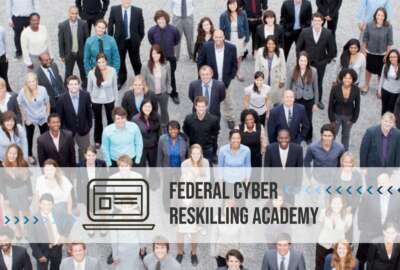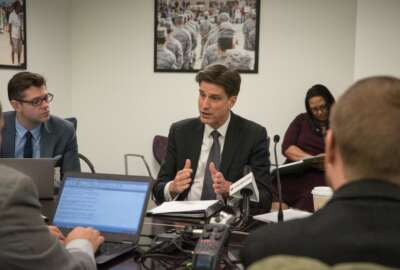

The Cybersecurity Reskilling Academy is accepting applications for a second cohort of students, this time open to the entire federal workforce.
Just a few short months after the administration first declared success with the uptake in its initial cohort, the CIO Council wants to ramp up and scale its Federal Cybersecurity Reskilling Academy to a broader audience.
The council is accepting applications now for its second cohort in the reskilling academy, Suzette Kent, the federal chief information officer, announced Tuesday.
Applications are open through May 15, and applicants must complete two online assessments by May 22. The reskilling academy will select participants starting in early June. Eight weeks of in-classroom training will run from July 8 through September 20.
Unlike the first cohort, which was open to all federal employees who don’t currently work in the IT field, the second round is open to the entire workforce.
“Our second set of reskilling activities are kicking off,” Kent said at the GDIT Emerge conference in Washington. “We have more that are following. That’s the way that we’re reinvesting and ensuring that in all the things we’re doing on the technology side, we’re making an investment in the people.”
The reskilling academy’s first class includes about 30 employees from 11 different agencies, Kent said. Demand forced the CIO Council to add more students to the first class than initially planned. The council itself searched and found additional funding to add five additional students to take the academy classes virtually.
Further investments to reskill and retrain the existing federal workforce for new, advanced technology of the future are coming soon, Kent said.
“We’re also working on how we build some of those skills in conjunction with our national labs, and when we look at the capabilities that we already have in taking innovation and big ideas from those environments and lab to market,” she said. “How can we leverage those learnings to move faster? Those are some of the things that you’ll see in [the] May and June time frame.”
Advancing the technical acumen of the federal workforce is also a priority for individual agencies. After all, agencies can’t quickly migrate to the cloud or adopt robotic process automation (RPA) and artificial intelligence unless their employees have a deeper knowledge base.
The Department of Homeland Security grappled with these questions as it considered how it might its current data environment, said John Zangardi, the DHS chief information officer. DHS sees an opportunity to slowly begin using RPA and machine learning to automate some of its internal business processes in procurement, human resources and finance.
“I don’t have a robust [research and development] to do that, so I’m going to be leveraging what comes out of industry,” Zangardi said. “Part of it is to make sure that you have the people who have the right technical skills. It’s less about the technology and more about the people and culture. [It’s about getting] them used to integrating this into their day-to-day actions. Integrating it on the business side is easier than integrating it on the mission side.”
DHS spent the last 18 months focused on exactly how the department might grow the technical acumen of its employees, Zangardi said.
First, DHS used the traditional hiring process to recruit new talent to scientific and professional executive positions and more college interns.
Zangardi’s CIO shop is sending one DHS employee to receive his systems engineering master’s degree.
“You have to be willing to put in a good year-plus of hard work,” he said. “We’re going to pay their salary and we’re going to get them a systems engineering degree … and we’re going to give them an obligation [to the department].”
Helping one DHS employee obtain higher education is a small step, but it’s a start.
Sharing and scaling these workforce programs and investments to a section of the federal workforce is the next step. That’s where industry can help, Kent said.
“Our challenge is to break down the silos to sustain innovation but to scale,” she said. “To scale, we have to work collaboratively with our partners with industry to ensure that the accomplishments and the great ideas of today don’t burn out and dwindle. It’s a process.”
The Defense Department is struggling with this question as it looks to expand and fully staff its Joint Artificial Intelligence Center (JAIC).
“Our biggest challenge continues to still be people,” Dana Deasy, the Pentagon’s CIO, said. “That probably wouldn’t surprise you. There’s a variety of different types of people [we] need. We need architects, and you need engineers. You need data scientists.”
The JAIC currently has civilian DoD employees, detailees and federal contractors. The goal, Deasy said, is to staff the AI center with 70 people by the end of the year. The JAIC had only three people when it initially launched last fall, and DoD has nearly met its workforce goal.
The center’s output so far is impressive, Deasy said, even as it looks to add more people. The JAIC has been quietly working on two pilot programs since last June and unveiled its official artificial intelligence strategy with more fanfare earlier this year. It came on the heels of the President Donald Trump’s new AI executive order.
The JAIC delivered the first version of a new algorithm designed to predict maintenance for the H-60 helicopter to the Special Operations Command three weeks ago. The version of another pilot designed to identity fire lines during extreme wildfires is almost ready for primetime, Deasy said.
Those pilots should reach their second, third and fourth iterations in fiscal 2020, he said. More pilots are on the way. The JAIC is eyeing a new project that would use artificial intelligence to review patient data from the Department of Veterans Affairs and map out potential options to mitigate suicide. A “cyber-sensing” pilot is also under consideration, Deasy added.
Copyright © 2025 Federal News Network. All rights reserved. This website is not intended for users located within the European Economic Area.
Nicole Ogrysko is a reporter for Federal News Network focusing on the federal workforce and federal pay and benefits.
Follow @nogryskoWFED


